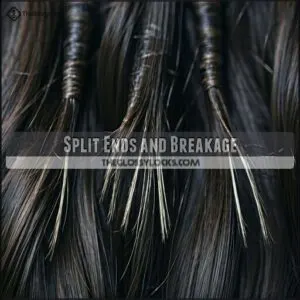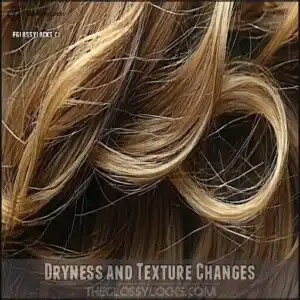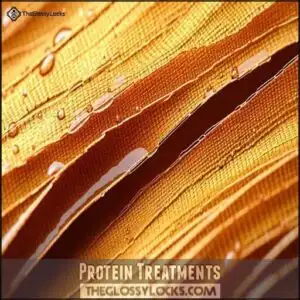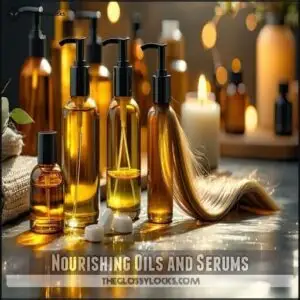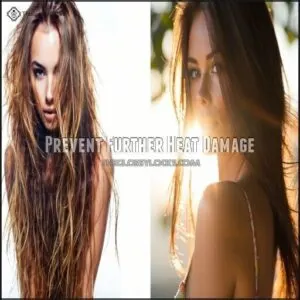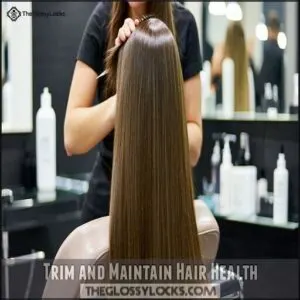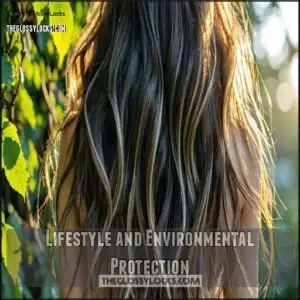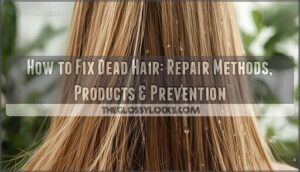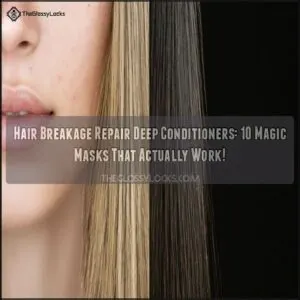This site is supported by our readers. We may earn a commission, at no cost to you, if you purchase through links.
 To repair heat damaged hair quickly, start with weekly protein treatments and deep conditioning masks to restore strength and moisture.
To repair heat damaged hair quickly, start with weekly protein treatments and deep conditioning masks to restore strength and moisture.
Cut back on heat styling; when you must use it, apply a heat protectant spray first.
Nourish your hair with argan or coconut oil applied to damp ends, and switch to a microfiber towel to reduce friction.
Consider a trim to remove split ends, and use leave-in conditioners daily, as damaged strands are like thirsty plants—they need consistent hydration to bounce back.
Those weekly hair masks aren’t just self-care; they’re your secret weapon in transforming straw-like strands into silky locks overnight.
Table Of Contents
- Key Takeaways
- Identify Heat Damage Signs
- Repair Strategies for Quick Results
- Prevent Further Heat Damage
- Hydration and Moisture Techniques
- Trim and Maintain Hair Health
- Lifestyle and Environmental Protection
- Frequently Asked Questions (FAQs)
- Can you bring your hair back from heat damage?
- How can I repair my damaged hair after straightening?
- How long does heat damage recovery take?
- Can diet affect heat damage repair?
- Are scalp treatments helpful for damaged hair?
- Do hair growth supplements repair heat damage?
- Can swimming pools worsen heat-damaged hair?
- Conclusion
Key Takeaways
- You’ll repair heat damage faster with weekly protein treatments and deep conditioning masks that restore your hair’s strength and moisture balance – think of these as essential building blocks for recovery.
- You should minimize heat styling and always apply a heat protectant spray when you must use hot tools – this prevents further damage while your hair heals.
- You’ll see significant improvement by incorporating nourishing oils like argan or coconut oil on damp ends and using leave-in conditioners daily to maintain consistent hydration.
- You won’t fully recover without regular trims to remove split ends – damaged ends can’t be repaired and will continue to split upward if not removed, which is why regular trims are necessary.
Identify Heat Damage Signs
You’ll notice heat damage in your hair through split ends, excessive dryness, and a rough texture that feels unmanageable even after conditioning.
Recognizing these warning signs early helps you take immediate action before breakage worsens and your strands become increasingly difficult to style, which is a complete concept to consider for immediate action.
Split Ends and Breakage
The telltale signs of heat damaged hair often begin with split ends and breakage.
You’ll notice your hair snapping off easily when brushed or tiny white nodules at the hair shaft ends.
This indicates protein loss and compromised hair elasticity.
When your strands break before stretching, it’s a clear sign of irreversible damage affecting cuticle integrity.
Regular trims are essential for removing these damaged sections while working to restore moisture balance.
Dryness and Texture Changes
While split ends show damage at the tips, your hair’s overall condition reveals the full story.
Split ends are just the tip of the iceberg—your hair’s overall texture tells the real damage story.
Heat damaged hair often becomes noticeably dry despite regular conditioning. You’ll feel the texture change—once silky strands turn rough, brittle, and straw-like.
The cuticle damage increases porosity levels, making moisture retention nearly impossible. Watch for elasticity reduction too; healthy hair stretches and returns, but damaged strands snap like twigs.
This hair brittleness is your scalp’s cry for help.
Styling Difficulties
When your hair starts fighting your styling routine, it’s sending an SOS.
You’ll notice manageability issues as your brush snags on unruly texture.
Heat damaged hair loses elasticity and lacks volume, refusing to hold styles that once came easily.
Your favorite curls fall flat, waves won’t form, and straight styles frizz within hours.
Even basic hair styling tools can’t tame the hair frizz and hair tangles that now define your morning struggle.
Repair Strategies for Quick Results
You’ll see noticeable improvement in your heat-damaged hair within just one week by implementing targeted repair techniques.
You can restore moisture, strengthen protein bonds, and smooth cuticles with the right combination of deep conditioning masks, protein treatments, and nourishing oils.
Deep Conditioning Masks
Now that you’ve spotted the signs of heat damage, it’s time for serious repair.
Deep conditioning masks are your new best friend for quick recovery.
These rinse-off treatments contain concentrated moisturizers like avocado oil and shea butter that work wonders on parched strands.
Apply a mask 2-3 times weekly instead of regular conditioner for intense hydration from root to tip, addressing heat styling damage at its core.
Many consumers purchase these conditioning products to improve hair health.
Protein Treatments
While deep conditioning adds moisture, your heat-damaged strands also need structure.
Protein treatments work like tiny repair crews, filling in gaps and broken bonds caused by heat styling damage.
Apply these powerhouse treatments to damp hair weekly, leaving on for 5-7 minutes.
Products containing keratin, collagen, or hydrolyzed proteins deliver quick results, strengthening fragile strands from within.
These treatments fill gaps in the hair cuticle, creating a smoother surface.
Just don’t overdo it—protein overload can make hair stiff rather than supple.
Nourishing Oils and Serums
While protein treatments rebuild your hair’s structure, nourishing oils and serums serve as the final touch in your repair arsenal.
They seal in moisture and create a protective barrier against further damage.
For maximum hair damage repair benefits:
- Choose serums with plant-based keratin for strength
- Layer lightweight oils over leave-in conditioners for product layering efficiency
- Apply oils to damp hair, focusing on ends where damage concentrates
Don’t skip this step—these products work overnight while you sleep! Many people find success using plant based options.
Prevent Further Heat Damage
While repairing your damaged locks is essential, you’ll need to halt ongoing damage to see lasting results.
You’ll make substantially faster progress by incorporating heat protectants before styling, lowering your tool temperatures, and embracing heat-free styling options at least every other day.
Heat Protectants
While you’re working on repairing damaged strands, prevention is your next best strategy.
Always apply heat protectant sprays before using any styling tools. Look for products containing silicones, proteins, or natural oils.
Spritz evenly on damp hair, ensuring complete coverage from roots to ends. Many users buy quality sprays for best results.
For a DIY protectant, mix argan oil with water in a spray bottle. Remember: the right protectant ingredients create an invisible shield against heat damage.
Low-Heat Styling Tools
Now that you’ve armed yourself with heat protectants, let’s talk about the styling tools you’re using.
Your choice of heat styling tools can make a huge difference in your hair repair journey.
For minimizing heat damage while styling, consider these four game-changers:
- Ceramic or tourmaline styling irons that distribute heat evenly across your strands
- Adjustable temperature control tools that let you keep heat below 300°F for fine hair
- Single-pass styling tools that reduce your overall heat exposure time
- Blow-dry brushes with cool air settings for adding volume without excessive heat
The right tool material and temperature control can dramatically reduce hair breakage while you repair your heat damaged hair.
Heat-Free Styling Options
While quality tools minimize damage, sometimes your hair needs a complete heat break.
Try these heat-free styling options to give your strands time to recover: twist and pin updos create elegant looks without heat, while scarves add style while protecting fragile strands.
The wet-setting technique delivers bouncy curls without blow-drying, and the banding method helps stretch curly hair naturally.
Even a simple wet bun offers sophistication without compromising your hair’s healing journey.
Hydration and Moisture Techniques
You’ll need to flood your parched strands with moisture to reverse heat damage and restore your hair’s natural resilience.
Incorating overnight hydration treatments and consistently using leave-in products will transform your brittle locks into soft, manageable hair within just one week, which can help achieve natural resilience.
Overnight Hair Masks
Overnight hair masks are a lifesaver for heat-damaged hair.
Overnight hair masks deeply nourish and transform brittle strands, giving you softer, healthier hair by morning.
Look for mask ingredients like shea butter or argan oil to lock in moisture. Apply evenly, focusing on dry ends, and wrap your hair for better absorption.
Use DIY recipes with coconut oil or avocado for quick results. Minoxidil treatments can also stimulate hair regrowth.
Repeat twice weekly for overnight hair repair and noticeable improvement in texture.
Leave-in Conditioners
Leave-in conditioners are a secret weapon for hair repair, especially with heat-damaged hair.
Apply them to damp strands, focusing on ends, and let the leave-in treatment work its magic all day.
Look for hair conditioners with nourishing ingredients like aloe vera or keratin for hydration and damage control.
Skip heavy formulas; lightweight options protect, soften, and won’t weigh hair down.
Environmental Moisture
Boost your hair’s moisture balance, even in dry climates, by using a cool-mist humidifier.
It combats climate impact by increasing air humidity, preventing further dryness and hair breakage.
Pair this with hair repair products like a hydrating hair mask for damage or a lightweight hair repair serum.
Proper moisture helps with damaged hair treatment and supports long-term hair health.
Trim and Maintain Hair Health
Regular trims are essential for removing split ends and preventing further damage to your hair.
By maintaining your hair’s health with gentle detangling and protective hairstyles, you can stop breakage in its tracks and promote stronger growth.
Regular Trims
One step to repair hair at home is booking regular trims to tackle damaged hair. Split ends don’t heal, but trimming every 6-8 weeks aids hair breakage repair.
Try these tips:
- Schedule professional trimming sessions.
- Use hair repair products weekly between cuts.
- Maintain shape for healthier, fuller growth.
It’s about progress, not instant perfection.
Gentle Detangling
Gentle detangling is essential for repairing heat-damaged hair and avoiding further breakage.
Use a wide-tooth comb or try finger detangling on damp hair for knot prevention. Wet detangling works best with detangling sprays to reduce tension and protect fragile strands.
Brush from the ends upward, tackling small sections gradually. For best results, consider using detangling tools to minimize hair damage.
This method supports hair breakage repair while preserving overall health.
Protective Hairstyles
To protect heat-damaged hair, choose low-tension styles, like loose buns or braids, to prevent breakage and boost scalp health.
Prioritize heat-free hairstyles for hairstyle longevity and minimize stress on fragile strands.
Avoid product buildup by cleansing regularly and use a silk scarf for night protection.
Pair with a heat protectant to reduce the impact of heat styling tools over time.
Lifestyle and Environmental Protection
Protecting your hair from sun, wind, and harsh chemicals is essential for repairing damage and preventing further harm.
Simple changes like wearing a hat outdoors and being mindful of chemical treatments can help restore your hair’s strength and shine.
Sun and Wind Protection
Sun and wind exposure can wreak havoc on your hair, causing environmental damage like dryness, frizz, and even scalp sunburn.
Use UV hair shields to block harmful rays and restore hydration balance.
Opt for protective styles like braids or buns to minimize wind damage.
Don’t forget a lightweight hat—it’s stylish and doubles up as hair protection against UV rays.
Chemical Treatment Care
Chemically treated hair deserves extra TLC to avoid added damage.
Pairing smart habits with thoughtful products can make a world of difference.
- Stick to gentle cleansing with sulfate-free shampoos.
- Load up on Post-Treatment Hydration weekly with deep conditioners.
- Prioritize Color Protection by skipping frequent heat styling.
- Boost Protein Balance using a hair strengthening treatment.
- Regularly monitor scalp health for lasting results.
Healthy Hair Habits
Start with your scalp health; it’s the foundation of hair repair.
A balanced diet impacts hair health more than you think, so load up on vitamins. Prioritize sleep quality for natural recovery, and practice stress reduction to combat hair damage.
Supplements like biotin boost hair care efforts, ensuring heat-damaged hair recovers faster. Small changes, huge results!
Start with your scalp health; it’s the foundation of hair repair. A balanced diet impacts hair health more than you think, so load up on vitamins. Prioritize sleep quality for natural recovery, and practice stress reduction to combat hair damage.
Supplements like biotin boost hair care efforts, ensuring heat-damaged hair recovers faster. Zinc aids follicle strength and can further enhance hair health. Small changes, huge results!
Frequently Asked Questions (FAQs)
Can you bring your hair back from heat damage?
You can’t fully restore heat-damaged hair, but you can improve its appearance with regular deep conditioning, protein treatments, and trims.
Focus on prevention by using heat protectants and limiting hot tool usage.
How can I repair my damaged hair after straightening?
Nearly 70% of women regularly use heat styling tools.
Trim split ends, use deep conditioning treatments, apply heat protectant, and give your hair weekly protein masks.
Limit heat styling until your hair recovers its natural bounce.
How long does heat damage recovery take?
Heat damage recovery typically takes 3-6 months, depending on severity.
You’ll need consistent deep conditioning, protein treatments, and regular trims.
Be patient—your hair won’t bounce back overnight, but improvement will come gradually.
Can diet affect heat damage repair?
Nearly 70% of hair nutrients come from your diet.
Your nutrition directly impacts hair repair – proteins build strength, omega-3s reduce inflammation, and biotin promotes growth.
Include eggs, salmon, and nuts to speed recovery.
Are scalp treatments helpful for damaged hair?
Yes, scalp treatments can benefit damaged hair by nourishing follicles and creating a healthier foundation for growth.
You’ll see better results using treatments with ingredients like aloe vera or tea tree oil.
Do hair growth supplements repair heat damage?
Studies show scientific evidence supporting hair supplements’ benefits remains limited and inconclusive.
You can’t repair existing heat damage with supplements alone. Your best bet is combining regular trims with quality protein-rich products while minimizing future heat exposure.
Many supplements contain vitamins and minerals, but the FDA doesn’t approve them for hair growth.
Can swimming pools worsen heat-damaged hair?
Swimming pools can definitely worsen heat-damaged hair.
Chlorine strips away natural oils from already vulnerable strands, penetrating open cuticles and causing further brittleness.
Wet your hair before swimming and rinse immediately after to minimize damage.
Conclusion
Remember when you thought your scorched strands were beyond saving?
Turns out, you can repair heat damaged hair quickly with consistent effort.
By incorporating protein treatments, heat-free styling, and daily moisture into your routine, you’ll see transformation within days.
Don’t forget that trim—damaged ends rarely recover fully.
Your hair’s health is in your hands; treat it with care now, and you’ll thank yourself when those silky, resilient locks return next week.

